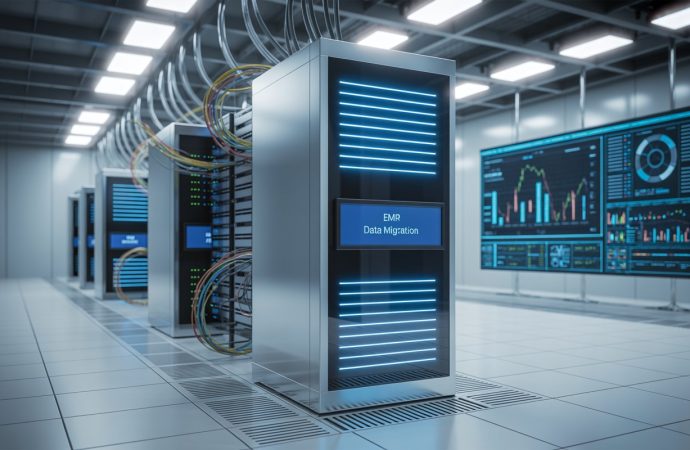Introduction In today’s healthcare world, digital records are the backbone of patient care. Electronic Medical Records (EMR) help doctors, nurses, and medical staff access important patient information quickly. But what happens when healthcare providers switch from one EMR system to another? That’s where EMR data migration services come in. These services help move patient records
Introduction
In today’s healthcare world, digital records are the backbone of patient care. Electronic Medical Records (EMR) help doctors, nurses, and medical staff access important patient information quickly. But what happens when healthcare providers switch from one EMR system to another? That’s where EMR data migration services come in. These services help move patient records from old systems to new ones smoothly and safely.
EMR data migration is a critical step for any healthcare organization upgrading their technology or merging with another provider. It ensures no patient information is lost or misplaced. This article will explain what EMR data migration services are, why they matter, and how they help create seamless healthcare transitions.
What is EMR Data Migration?
EMR (Electronic Medical Record) data migration is the process of transferring patient records and healthcare information from one system to another. This could involve upgrading to a newer EMR platform, consolidating multiple healthcare databases, or moving to a cloud-based solution for improved accessibility. The goal is to ensure continuity of care without losing any crucial data.
Key Challenges in EMR Data Migration
While EMR data migration is essential, it comes with several challenges:
- Data Complexity: EMRs contain both structured data (like lab results and billing codes) and unstructured data (such as physician notes and images). Migrating both types accurately is tricky.
- System Compatibility: Not all EMR systems are compatible with each other. Some require data transformation or mapping before migration.
- Downtime Risks: Healthcare operations cannot afford long periods of system downtime. Migration must be planned to minimize disruptions.
- Compliance Requirements: Regulations like HIPAA and GDPR dictate strict data handling protocols. Any oversight could lead to hefty fines.
Importance of Secure Healthcare Data Transfer
Security is non-negotiable in healthcare. Transferring patient records exposes sensitive data to potential breaches if not handled properly. Implementing end-to-end encryption and strict user authentication is critical to safeguarding patient information during migration.
1. Critical Steps in EMR Data Migration
Pre-Migration Assessment and Planning
Before initiating migration, it’s crucial to:
- Inventory Existing Data: Know what data exists and where it’s stored.
- Assess Data Quality: Identify and clean up outdated or duplicate records.
- Map Data Fields: Ensure that data fields in the old system align with those in the new system.
Skipping these steps can lead to costly errors and data inconsistencies.
2. Data Extraction and Transformation
Once planning is complete, the actual extraction begins. This involves:
- Extracting Data: Pulling data from legacy systems.
- Transforming Data: Converting data into a compatible format for the new system.
- Loading Data: Importing the transformed data into the new system.
Automated extraction tools can significantly reduce manual errors and speed up the process.
3. Data Validation and Quality Assurance
After migration, it’s essential to:
- Automate Checks: Detect missing fields, format inconsistencies, and data corruption.
- Manual Review: Clinicians or IT staff verify that critical medical data is intact.
Combining both approaches ensures near-perfect data fidelity, which is vital for patient safety.
4. Post-Migration Testing and Support
Migration doesn’t end once the data is moved. Post-migration activities include:
- Testing Workflows: Ensuring EMR functions as expected, including patient registration, billing, and lab reporting.
- User Training: Clinicians must adapt to the new interface.
- Continuous Support: Fixing unexpected issues quickly to prevent downtime.
Thorough post-migration support leads to faster adoption and fewer errors in the new system.
Ensuring Security and Compliance in EMR Migration
1. HIPAA and Regulatory Compliance
Healthcare data is heavily regulated. Migrating EMRs must comply with HIPAA in the U.S., GDPR in Europe, and local healthcare laws. Embedding compliance checks into the migration process—like automatic audit logs and access monitoring—prevents legal risks.
2. Data Encryption and Access Controls
Encryption is your best friend during migration. Data should be encrypted both in transit and at rest. Additionally, role-based access controls ensure only authorized personnel handle sensitive information.
3. Risk Management and Mitigation Strategies
Even with precautions, risks exist. Common mitigation strategies include:
- Backup Systems: Always have a full backup before migration.
- Sandbox Testing: Trial runs in a controlled environment.
- Disaster Recovery Plans: Quick restoration in case of failure.
Implementing these measures ensures smooth transitions without patient care disruption.
Tools and Technologies Driving EMR Data Migration
1. Automated Migration Tools Overview
Automation tools streamline data transfer, reducing human error and speeding up the process. Tools like Abto Software’s EMR migration services offer end-to-end solutions, handling data extraction, cleansing, standardization, alignment, formatting, and import.
2. Role of AI and Machine Learning in Data Migration
AI is transforming migration. Machine learning algorithms can:
- Predict Mapping Errors: Identify potential issues before they occur.
- Detect Anomalies: Spot inconsistencies in patient records.
- Automate Repetitive Tasks: Convert legacy codes and formats.
AI-driven tools can complete migrations faster and more reliably.
3. Cloud-based vs On-Premise Migration Solutions
Cloud migrations offer scalability and remote accessibility, whereas on-premise solutions provide greater control and local security. A hybrid approach often works best: critical data remains on-premise, while less sensitive information leverages cloud flexibility.
Comparison of Leading EMR Data Migration Service Providers
Here’s a comparison of some top EMR data migration service providers:
| Provider | Migration Speed | Security Features | Compliance Support | Cost Efficiency | Customer Support | Notable Clients |
| Abto Software | High | End-to-End Encryption | HIPAA, GDPR | Competitive | 24/7 Support | Major healthcare orgs |
| NextGen Healthcare | Medium | Standard Encryption | HIPAA | Moderate | Business Hours | Regional clinics |
| Cerner Corporation | High | Advanced Threat Detection | HIPAA, GDPR | Premium | 24/7 Support | Large hospital chains |
Abto Software stands out for speed, security, and round-the-clock support, making it ideal for large-scale migrations.
Benefits of Choosing Professional EMR Data Migration Services
1. Reducing Downtime and Maintaining Workflow Continuity
Professional services minimize operational interruptions. Hospitals using experienced providers report less than 2 hours of downtime, even for large migrations.
2. Enhancing Data Accuracy and Integrity
Professional teams ensure records are complete and error-free. Their validation processes eliminate up to 95% of migration errors.
3. Facilitating Interoperability Between Healthcare Systems
Professional migration ensures seamless interaction between different EMR systems. Clinics using professional services can easily share patient data with specialists and hospitals, improving overall care quality.
Future Trends in EMR Data Migration
1. Increasing Adoption of AI-Driven Migration
AI will continue to revolutionize EMR migration. Predictive algorithms will detect errors, optimize mapping, and reduce manual workload, making migrations faster and more reliable.
2. Blockchain for Data Security and Transparency
Blockchain is emerging as a game-changer for secure, traceable healthcare data transfers. Hospitals experimenting with blockchain can track every record movement, ensuring transparency and compliance.
3. Predictive Analytics for Migration Risk Management
Predictive analytics can forecast potential migration issues before they occur, such as missing fields, duplication, or system incompatibilities. Predictive tools cut risk exposure by nearly 50%.
Conclusion
EMR data migration services are essential for ensuring accurate patient records, compliance, and uninterrupted healthcare delivery. Investing in professional migration services like Abto Software saves time, reduces risk, and enhances overall system efficiency. With AI, automation, and predictive analytics on the rise, the future of EMR migration promises faster, safer, and smarter healthcare data management.
FAQs
Q1. What is the typical timeline for EMR data migration?
It varies based on the size and complexity of the data, but professional services can migrate most mid-sized hospitals in 2–4 weeks.
Q2. How do I ensure my patient data remains secure during migration?
Use end-to-end encryption, strict access controls, and trusted providers with HIPAA and GDPR compliance.
Q3. Can AI tools completely replace human oversight in EMR migration?
Not entirely. AI helps detect errors and optimize processes, but human validation is still critical for ensuring accuracy.
Q4. What are common risks during EMR migration?
Data loss, system downtime, duplicate records, and compliance breaches are typical risks. Professional services use mitigation strategies to address them.
Q5. Are cloud-based EMR migrations safe?
Yes, if proper encryption, access controls, and backup systems are in place. Hybrid solutions are often ideal.
Q6. How much does professional EMR data migration cost?
Costs depend on data volume, system complexity, and security requirements. Providers like Abto Software offer competitive pricing for comprehensive services.
Q7. Will migration affect ongoing patient care?
With proper planning and professional support, downtime is minimal, and patient care continues uninterrupted.
















